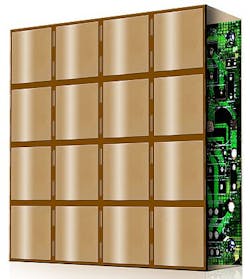DARPA to brief industry 18 March on program to create common RF phased array building blocks
ARLINGTON, Va., 1 March 2013. Military researchers are trying to save time and money in the development of RF phased arrays for radar, communications, and electronic warfare (EW) by creating common building blocks to help designers avoid starting from scratch every time they build a new RF array.
RF and microwave experts at the U.S. Defense Advanced Research Projects Agency (DARPA) in Arlington, Va., are launching the Arrays at Commercial Timescales (ACT) program to create a shared hardware basis for future military phased array development programs.
DARPA will brief industry on details and goals of the ACT program on 18 March 2013 at the DARPA Conference Center at 675 N. Randolph St. in Arlington, Va. A formal solicitation for the program should be released before the briefings.
The ACT program has three thrusts: a common building block for RF arrays; a reconfigurable way for the antenna to interact with radio waves; and over-the-air coherent array aggregation.
Phased arrays steer radio waves without using moving parts. These arrays use rows of tiny RF transceivers that send signals at slightly different times, or phases, to steer beams of radio waves. Building these arrays, however, historically has been a time-consuming and expensive custom process.
“What DARPA is looking for is essentially three tiers of technology that together form a configurable system that would serve as a starting point for any new array program,” says Bill Chappell, the DARPA Act program manager.
“Current DOD [U.S. Department of Defense] array development programs can take more than a decade and cost tens of billions of dollars," Chappell continues. "That’s because these programs start from zero, from a clean slate, every time and work toward an endpoint as specific as a radar system for a single class of warship."
It's this custom nature of RF phased array development that DARPA scientists want to avoid. We want to give those efforts a common foundation," Chappell says.
The first two thrusts of the ACT program seek to reduce the time and money it takes to develop RF phased arrays. The third thrust seeks to reduce the sizes of RF phased arrays by developing distributed phased arrays that can communicate with each other and work as one large array.
This portion of the ACT program expands on previous DARPA research on the Precision Electronic Warfare (PREW) initiative that sought to apply time and localization transfer to put RF waves on target precisely from different origin points.
Industry briefings will include a presentation by Chappell, brief presentations by academic and industry teams on current and planned efforts, and a short presentation on DARPA contracting. Individual meetings with Chappell will be available, and organizations can meet in a breakout room to discuss potential collaborations. Set up individual meetings by email at [email protected].
Companies interested in attending the briefings should register no later than 14 March 2013 online at www.signup4.net/public/ap.aspx?EID=ACTP10E&OID=130.
For questions or concerns about the industry briefings e-mail DARPA at [email protected]. with ACT Proposers’ Day in the subject line.
More information about the industry briefings is online at www.signup4.net/public/ap.aspx?EID=ACTP10E&OID=50.

